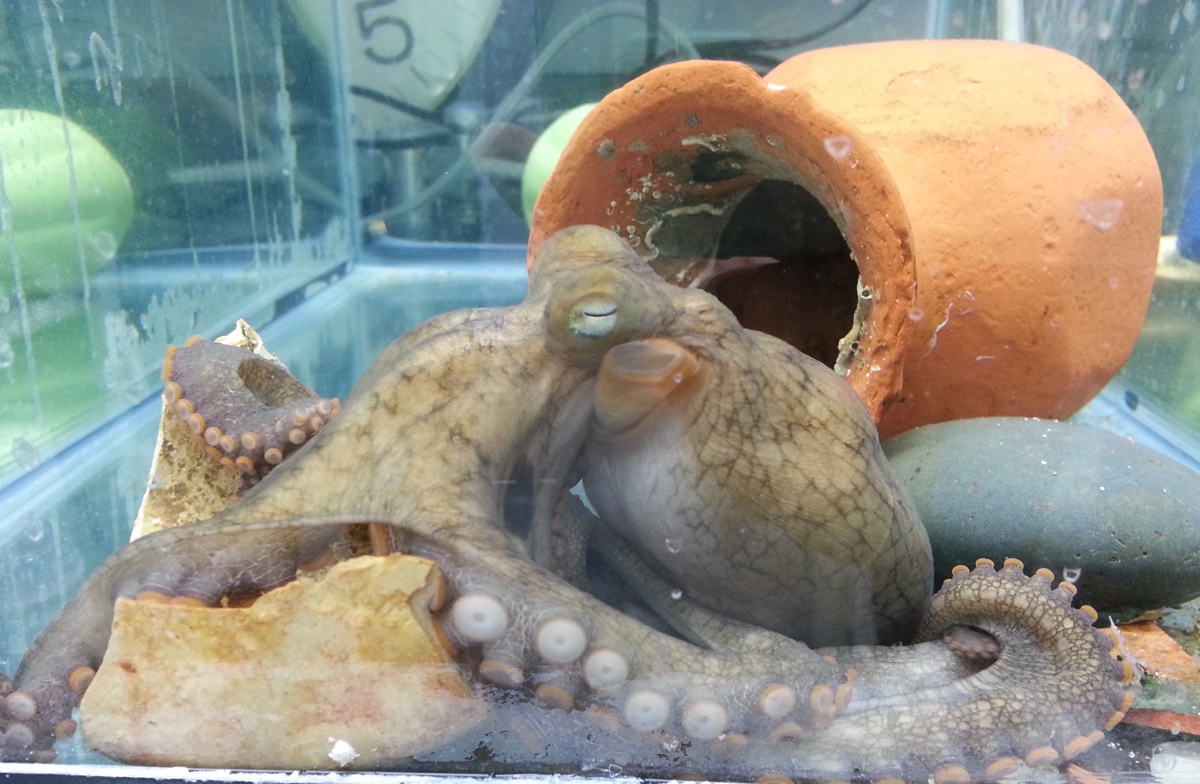Octopus Moms Enter Death Spiral Before Eight-Armed Bundles Are Born

For an octopus mom, the miracle of life is bittersweet. After wandering the seas alone, she meets up with a mate, collects his sperm and then goes on to deprive herself of any food while caring for her now-fertilized eggs. When it nears time for the little eight-armed bundles to hatch, the mom wastes away, entering an aquatic death spiral.
She never even gets to see the fruits of her labor, having perished by the time her young emerge from their eggs.
Now, researchers have found that the octopus mom does not go quietly into the night. Rather, the same optic gland that directs a female octopus to mate and brood her eggs also guides her on a suicide mission of sorts, directing the nurturing cephalopod to make haste with dying. [Octlantis: See Photos of Tight-Knit Gloomy Octopus Communities]
For their study, neurobiologists Z. Yan Wang and Clifton Ragsdale of the University of Chicago were interested in figuring out how the optic gland works. Specifically, they wanted to know which molecules are responsible for the gland's function in maternal behaviors. (Like the pituitary gland in humans, the optic gland is located between the eyes.)
To do that, the researchers monitored wild-caught female California two-spot octopuses (Octopus bimaculoides) in their lab. The experiment included mated and nonmated individuals, allowing the duo to look at tissues and genetics as well as behaviors of both groups of octopuses.
The brooding females, the scientists found, cared for their egg clutches for the first eight days, on average, blowing water over the eggs and stroking them with their suckers. The octo-moms also kept eating. "We were a bit surprised that there was a period of feeding while brooding that preceded the fasting period, because it hadn't been characterized before. Results like this demonstrate how much more there is to know in these animals," Wang told Live Science.
During the next stage of brooding, the females stopped eating; after about 11 days of fasting, the octopuses entered a rapid decline, the researchers wrote. Behaviorally, they seemed to be hastening death, the researchers said. [In Photos: Amazing 'Octomom' Protects Eggs for 4.5 Years]
Get the world’s most fascinating discoveries delivered straight to your inbox.
The researchers watched as new mothers rammed their mantles into the glass sides of the aquarium or the gravel at the bottom of the tank, leading to deep wounds that didn't heal. Some of the mothers took to excessively self-grooming their bodies. Rather than running the first pair of arms over the head and mantle, as is typical, these octopus moms groomed with all their arms, in somewhat of a flurry that created a "turbulent mass of entangled arms," which was followed by "self-cannibalization of the arm tips or suckers," the researchers wrote online Oct. 8 in the Journal of Experimental Biology.
"The overgrooming and self-mutilation are definitely odd to witness," Wang said.
And after the self-mutilation and cannibalism, the animals showed physiological signs that death was near: The skin around their eyes sank in, and their skin paled. Their pupils, which are usually aligned perpendicular with respect to gravity, shifted, suggesting deterioration in at least part of the central nervous system, the scientists wrote.
When the researchers analyzed the optic glands at different stages of the mothers' lives, they found that certain molecules related to gene expression were activated depending on which stage the mother was in. Specifically, they found that four different molecular "pathways" were activated for the four stages of the female octopus's reproductive life: unmated behaviors, feeding once eggs hatch, fasting and decline (the spiral toward death).
"These behaviors, along with our transcriptomic [genetic] evidence, strongly imply that post-reproductive death is an active process," the researchers said.
As for why the new mothers go to so much trouble to end their lives, the researchers said they ruled out the idea that the octopuses just didn't have the energy to reproduce again (and so what's the point of living?). Apparently, the only thing stopping them from reproducing again is the optic gland, according to the researchers, who suspect the hasty dying may be related to the animals' cannibalistic nature. The mother's death ensures she will not consume her young, the researchers said.
Next, the researchers hope to learn more about how the molecular pathways in the optic gland work, particularly those triggered by steroids and peptides, Wang said. "Follow-up studies such as these will reveal how similar or completely different this process may be to other known biological processes."
Originally published on Live Science.
Jeanna Bryner is managing editor of Scientific American. Previously she was editor in chief of Live Science and, prior to that, an editor at Scholastic's Science World magazine. Bryner has an English degree from Salisbury University, a master's degree in biogeochemistry and environmental sciences from the University of Maryland and a graduate science journalism degree from New York University. She has worked as a biologist in Florida, where she monitored wetlands and did field surveys for endangered species, including the gorgeous Florida Scrub Jay. She also received an ocean sciences journalism fellowship from the Woods Hole Oceanographic Institution. She is a firm believer that science is for everyone and that just about everything can be viewed through the lens of science.


